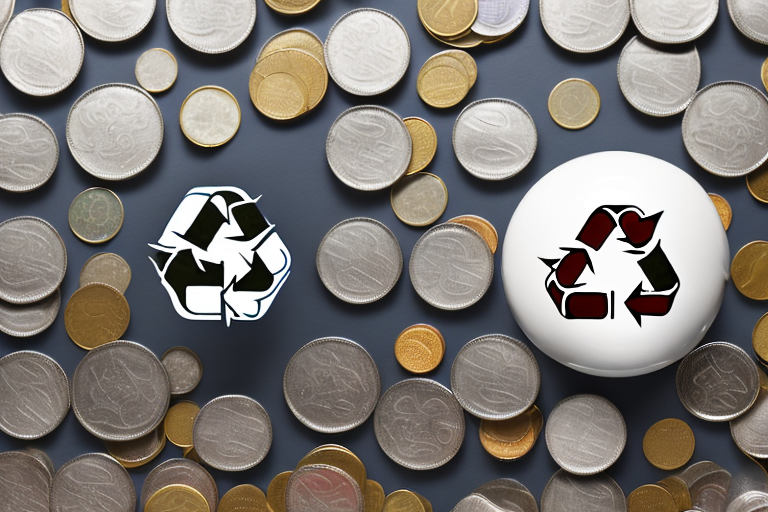Debt recycling and traditional debt repayment methods are two common approaches individuals use to manage their debt. Understanding how these methods work and comparing their pros and cons can help you make an informed decision about which approach is best for your financial health.
Understanding the Concept of Debt Recycling
Debt recycling is a strategy that involves using the equity in your home to invest in income-producing assets while simultaneously reducing your non-deductible debt. This method allows you to leverage the value of your property to generate potential tax benefits and build wealth in the long run.
Imagine this: you’re a homeowner with a mortgage, and you’ve been diligently making repayments to pay off your loan. However, you also have some non-deductible debt, such as credit card debt or a personal loan, that is not working in your favor. Debt recycling provides a solution to this predicament by allowing you to put your home equity to work for you.
But how does it work exactly and how does debt recycling work? Let’s dive into the mechanics of debt recycling to understand the process better.
The Mechanics of Debt Recycling
To implement debt recycling, you first need to access the equity in your property by increasing your mortgage or obtaining a home equity loan. This process allows you to tap into the value that has accumulated in your home over time. The funds obtained through this process can then be used to invest in assets such as shares, managed funds, or property that generate income or have the potential for capital growth.
By strategically using the equity in your property, you can diversify your investment portfolio and potentially increase your overall wealth. The concept of debt recycling is like a financial juggling act, where you balance your non-deductible debt reduction with the acquisition of income-producing assets.
As you continue to make regular repayments towards your mortgage, the non-deductible debt decreases while the deductible debt associated with your investment increases. This allows you to claim tax deductions on the interest paid on the investment loan, potentially reducing your overall tax liability.
Let’s say you invest in a rental property using the funds obtained through debt recycling. The rental income generated from the property can help offset the interest payments on the investment loan, reducing the burden on your finances. Over time, as the property appreciates in value, you may also benefit from capital gains.
Debt recycling is not a one-time transaction but rather an ongoing strategy. It requires careful monitoring of your investments, regular mortgage repayments, and a long-term perspective. By staying committed to the process, you can reap the rewards of debt recycling.

Benefits of Debt Recycling
One of the key benefits of debt recycling is the potential to create an additional income stream through your investments. By strategically using the equity in your property, you can generate returns that help pay off your non-deductible debt faster.
Imagine being able to use the income generated from your investments to accelerate the repayment of your credit card debt or personal loan. Debt recycling provides a pathway to financial freedom by allowing you to redirect your resources towards wealth creation.
Additionally, the tax benefits associated with debt recycling can be significant. By leveraging your property’s equity to invest in income-producing assets, you may be able to claim deductions on the interest paid on the investment loan, which can result in considerable tax savings.
These tax savings can be reinvested or used to further reduce your non-deductible debt. Over time, the compounding effect of these savings can have a substantial impact on your overall financial position.
However, it’s important to note that the tax implications of debt recycling can vary depending on your individual circumstances and the tax laws in your country. Consulting with a financial advisor or tax professional is crucial to ensure you understand the specific benefits and obligations associated with debt recycling.
Potential Risks and Downsides of Debt Recycling
While debt recycling has its advantages, it’s essential to consider potential risks and downsides. Investing in income-producing assets inherently carries risks, as their performance can be influenced by market fluctuations.
Before embarking on a debt recycling strategy, it’s crucial to conduct thorough research and seek professional advice to ensure you make informed investment decisions. Understanding the risks associated with different asset classes and having a diversified portfolio can help mitigate potential losses.
Furthermore, taking on additional debt to invest means you are increasing your overall level of financial leverage. While this can amplify your potential returns, it also exposes you to higher risks. It is crucial to assess your risk tolerance and ensure you have a solid plan in place to manage and mitigate potential losses.
Debt recycling requires discipline, careful financial management, and a long-term perspective. It is not a get-rich-quick scheme but rather a strategy that requires patience and diligence. By understanding the potential risks and downsides, you can make informed decisions and navigate the path to financial success.
In conclusion, debt recycling offers a unique opportunity to leverage the equity in your property to generate potential tax benefits and build wealth. By strategically using your home equity to invest in income-producing assets, you can create additional income streams and potentially reduce your non-deductible debt faster. However, it’s important to consider the potential risks and downsides and seek professional advice to ensure debt recycling aligns with your financial goals and risk tolerance.
Exploring Traditional Debt Repayment Methods
Aside from debt recycling, there are several traditional debt repayment methods that individuals use to eliminate their debts. These methods prioritize paying off debts in a specific order to streamline the repayment process.
When it comes to debt repayment, it’s important to find a method that works best for your financial situation and personal preferences. Let’s take a closer look at three popular methods: the Snowball Method, the Avalanche Method, and the Stack Method.
The Snowball Method
The snowball method involves paying off debts starting from the smallest balance to the largest. By focusing on clearing smaller debts first, individuals gain a sense of accomplishment and momentum, which can motivate them to continue their debt repayment journey.
This method allows borrowers to eliminate debts one by one, creating a psychological boost as each debt is eliminated. It provides a clear path and encourages individuals to stay committed to their repayment goals. However, it may not be the most financially efficient method, as it does not consider interest rates or overall debt amounts.
For example, let’s say you have two debts: a credit card balance of $1,000 and a student loan of $10,000. With the snowball method, you would focus on paying off the credit card balance first, even if the student loan has a higher interest rate. This method prioritizes the emotional satisfaction of crossing off debts from your list.
The Avalanche Method
The avalanche method, on the other hand, prioritizes debts with the highest interest rates. By tackling debts with the highest interest rates first, individuals save more on interest payments in the long run. This method is often viewed as the most financially efficient approach to debt repayment.
While the avalanche method may not provide the immediate satisfaction of eliminating smaller debts, it can significantly reduce the overall interest paid over the course of debt repayment. By targeting high-interest debts, individuals can minimize the impact of accumulating interest charges on their financial well-being.
Let’s consider the same example as before: a credit card balance of $1,000 with an interest rate of 20% and a student loan of $10,000 with an interest rate of 5%. With the avalanche method, you would prioritize paying off the credit card balance first, as it has a higher interest rate. This approach helps you save more money in the long run by minimizing interest costs.
The Stack Method
The stack method involves listing debts in order from the highest interest rate to the lowest. However, unlike the avalanche method, it also considers the size of the debt.
Using this method, individuals prioritize paying off the debt with the highest interest rate and the smallest balance. Once that debt is cleared, they move on to the next debt based on interest rate and size. This approach combines elements of both the snowball and avalanche methods, allowing individuals to benefit from both motivational milestones and interest savings.
Let’s revisit our previous example: a credit card balance of $1,000 with an interest rate of 20% and a student loan of $10,000 with an interest rate of 5%. With the stack method, you would still prioritize paying off the credit card balance first due to its higher interest rate. However, if you had another debt with a higher interest rate but a larger balance, you would focus on that debt next. This method provides a balanced approach that considers both interest rates and debt sizes.
Ultimately, the choice of debt repayment method depends on your financial goals, personal preferences, and the specific details of your debts. Whether you prefer the psychological boost of the snowball method, the financial efficiency of the avalanche method, or the balanced approach of the stack method, the key is to stay committed to your repayment plan and make consistent progress towards becoming debt-free. You can also read about Financial counselling by clicking here.
Comparing Debt Recycling and Traditional Debt Repayment
When comparing debt recycling and traditional debt repayment methods, several factors should be taken into account to determine which approach is most suitable for your situation.
Effectiveness in Debt Reduction
Debt recycling can potentially accelerate your debt reduction efforts by leveraging investments. However, traditional debt repayment methods can also be effective in eliminating debts if executed diligently and consistently. Assess your financial goals and the amount of debt you’re dealing with to decide which method aligns better with your objectives.
Impact on Credit Score
Both debt recycling and traditional debt repayment methods have an impact on your credit score. Debt recycling involves taking on additional debt to invest, which can increase your overall level of indebtedness. On the other hand, traditional debt repayment methods focus on gradually reducing your debts, which may have a positive impact on your credit score over time.
Suitability Based on Financial Situation
Consider your current financial situation and ability to manage additional debt or invest. Debt recycling requires careful planning and consideration of factors such as property values, investment potential, and your personal risk tolerance. Traditional debt repayment methods, however, may offer a more straightforward and manageable approach for individuals who prefer not to leverage their property or take on additional investments.
Making the Right Choice for Your Financial Health
Choosing the right debt repayment method is a crucial decision that can significantly impact your financial health. Consider the following factors to make an informed choice:
Factors to Consider When Choosing a Debt Repayment Method
- The amount of debt you owe and its interest rates
- Your risk tolerance and investment knowledge
- Your long-term financial goals
- Your ability to manage and monitor investments
Seeking Professional Financial Advice
It is always wise to seek professional financial advice when making decisions that have a significant impact on your financial well-being. Consulting with a qualified financial advisor can help you understand the nuances of debt recycling and traditional debt repayment methods and assess which approach aligns better with your unique circumstances.
The Role of Personal Discipline in Debt Repayment
Regardless of the method you choose, personal discipline plays a critical role in successfully managing debt. Create a realistic budget, track your expenses, and prioritize your debt repayments accordingly. Consistency and perseverance are key to achieving long-term financial stability.In conclusion, carefully consider your financial goals, risk tolerance, and overall debt situation when deciding between debt recycling and traditional debt repayment methods. Both approaches have their benefits and drawbacks. By evaluating your circumstances and seeking professional advice, you can make an informed choice that sets you on the path to financial freedom and well-being.
